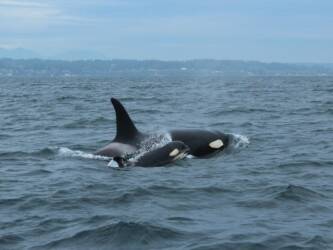by Friends of the San Juans
Last year the Washington State Legislature passed a new law requiring boaters to stay 1,000 yards away from the critically endangered Southern Resident orcas, beginning in January 2025. With the opening of the boating season, national and regional conservation groups encourage boaters to take the voluntary pledge at givethemspace.org and give the whales the space they need today.
The Southern Resident orca population currently consists of 74 individuals, nearing their historical low of 71. “There are nine calves under 5 years old in the population, including Tahlequah’s newest calf, and six of those are female,” said Donna Sandstrom, director of The Whale Trail. “The future of the population is here. Their ability to survive and thrive into adulthood depends on the actions that we take today.”
“Our goal is that every boater in Puget Sound, and through the Southern Resident orcas’ range, will take this pledge, and do their part to give the whales the space they need, even before it is required,” said Rein Attemann, Puget Sound senior campaign manager at Washington Conservation Action. “Boaters have a unique opportunity to play a role in the Southern Residents’ recovery, simply by avoiding them while at sea, and making it easier for the whales to find and catch their prey.”
“The Southern Residents are on the brink of extinction due to human-caused threats, including lack of prey, toxic contaminants and disturbance by boats and noise,” said Kathleen Callaghy, Northwest representative at Defenders of Wildlife. “Giving the whales space is the simplest and most immediate way we can help them, and we don’t have to wait until 2025 to do so.”
The law implements a recommendation from the Washington Department of Fish and Wildlife (WDFW) based on recent science showing that when vessels approach closer than 1,640 yards it significantly reduces the whales’ ability to find and catch prey. The harm from vessel noise and disturbance is more pronounced in females, who abandon hunts when boats approach closer than 400 yards.
Currently, commercial whale-watching operators are required to stay 1,000 yards away from Southern Residents most of the year, while other boaters are allowed to approach as close as 300 yards. The new law resolves that difference. Having one distance for the majority of boaters gives the whales the space they need to forage successfully, and the rule will be easier to communicate, comply with and enforce.
“Even though the distance requirement is not mandatory until 2025, there’s no reason to wait to give the whales the space they need,” said Lovel Pratt, marine protection and policy director at Friends of the San Juans.
“On the long road to recover the Southern Residents, Washington State has taken a big step forward,” said Miguela Marzolf, ocean policy coordinator at the Seattle Aquarium. “We encourage the federal governments of Canada and the United States to follow suit and give the whales the space they need throughout their range.”
“WDFW’s Orca Regulations Communications Advisory Group, or ORCA Group, is working hard to help the Department get the word out about the upcoming change to the distance regulations,” said Julie Watson, WDFW’s Killer Whale Policy Lead. “Everyone can help by spreading the word and setting an example now by practicing the 1,000-yard setback before it goes into effect in 2025.”



